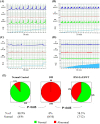Therapeutic effect of Low intensity Extracorporeal Shock Wave Therapy (Li-ESWT) on diabetic bladder dysfunction in a rat model
- PMID: 33628099
- PMCID: PMC7893573
- DOI: 10.7150/ijms.55274
Therapeutic effect of Low intensity Extracorporeal Shock Wave Therapy (Li-ESWT) on diabetic bladder dysfunction in a rat model
Abstract
Objectives: Low intensity extracorporeal shock wave therapy (Li-ESWT) has proven to be effective and safe for the treatment of various urological disorders including erectile dysfunction and chronic pelvic pain syndrome. In this study, we elucidated the therapeutic effect and possible mechanisms of Li-ESWT on diabetic bladder dysfunction (DBD) in a rat model. Materials and Methods: In all, thirty-two female Sprague-Dawley rats were divided into three groups: normal control (NC), diabetes mellitus (DM) control, and DM Li-ESWT. The two DM groups were given high fat diets for one month, followed by 2 intraperitoneal injections of streptozotocin (STZ) 30 mg/kg separated by one week. Body weight and fasting blood glucose were monitored every week. Only rats with fasting blood glucose 140 mg/dL or more were considered diabetic and used in the subsequent portions of the study. The Li-ESWTs were applied toward the pelvis of the rats twice a week for 4 weeks with energy flux density (EFD) 0.02 mJ/mm2, 500 shocks, at 3Hz. All rats underwent plasma insulin tolerance test, conscious cystometry, leak-point pressure (LPP) assessment, and immunohistochemical studies. Results: DM groups had significantly lower insulin sensitivity and higher body weight. Conscious cystometry also revealed voiding dysfunctions. In the DM Li-ESWT group, the rats had significantly improved voiding functions that were reflected in longer micturition intervals and higher LPP compared to DM control. Immunofluorescence in DM control groups showed increased tyrosine hydroxylase (TH) expression and decreased neuronal nitric oxide synthase (nNOS) expression in the longitudinal urethral smooth muscles. Besides, rats had dilations and deformities of suburothelium capillary network of the bladder, revealing the deterioration of the nerve function of the urethra and destruction of the vascularization of the bladder. However, the DM Li-ESWT group exhibited recovery of the nerve expression of the urethra and vascularization of bladder. Conclusions: Li-ESWT ameliorates the bladder dysfunction and urinary continence in the DBD rat model, reflected in restoration of the nerve expression of the urethra and the vascularization of the bladder. Non-invasive Li-ESWT could be an alternative therapeutic option for DBD.
Keywords: bladder dysfunction; diabetes mellitus; low intensity extracorporeal shock wave.
© The author(s).
Conflict of interest statement
Competing Interests: The authors have declared that no competing interest exists.
Figures




Similar articles
-
Low-intensity extracorporeal shockwave therapy ameliorates diabetic underactive bladder in streptozotocin-induced diabetic rats.BJU Int. 2018 Sep;122(3):490-500. doi: 10.1111/bju.14216. Epub 2018 Apr 20. BJU Int. 2018. PMID: 29603534 Free PMC article.
-
Delayed Treatment With Low-intensity Extracorporeal Shock Wave Therapy in an Irreversible Rat Model of Stress Urinary Incontinence.Urology. 2020 Jul;141:187.e1-187.e7. doi: 10.1016/j.urology.2020.03.035. Epub 2020 Apr 10. Urology. 2020. PMID: 32283169 Free PMC article.
-
Delayed Low-Intensity Extracorporeal Shock Wave Therapy Ameliorates Impaired Penile Hemodynamics in Rats Subjected to Pelvic Neurovascular Injury.J Sex Med. 2019 Jan;16(1):17-26. doi: 10.1016/j.jsxm.2018.11.003. Epub 2018 Dec 1. J Sex Med. 2019. PMID: 30509508 Free PMC article.
-
Low-intensity extracorporeal shockwave therapy for diabetic men with erectile dysfunction: A systematic scoping review.Andrology. 2023 Feb;11(2):270-281. doi: 10.1111/andr.13197. Epub 2022 Jun 8. Andrology. 2023. PMID: 35642619
-
Low-Intensity Extracorporeal Shockwave Therapy for Erectile Dysfunction in Diabetic Patients.Sex Med Rev. 2021 Oct;9(4):619-627. doi: 10.1016/j.sxmr.2019.06.007. Epub 2019 Aug 1. Sex Med Rev. 2021. PMID: 31378506 Review.
Cited by
-
Low-Intensity Extracorporeal Shock Wave Therapy Promotes Bladder Regeneration and Improves Overactive Bladder Induced by Ovarian Hormone Deficiency from Rat Animal Model to Human Clinical Trial.Int J Mol Sci. 2021 Aug 27;22(17):9296. doi: 10.3390/ijms22179296. Int J Mol Sci. 2021. PMID: 34502202 Free PMC article. Clinical Trial.
-
Effects of electroacupuncture on bladder dysfunction and the expression of PACAP38 in a diabetic rat model.Front Physiol. 2023 Jan 9;13:1008269. doi: 10.3389/fphys.2022.1008269. eCollection 2022. Front Physiol. 2023. PMID: 36699677 Free PMC article.
-
Established and emerging treatments for diabetes-associated lower urinary tract dysfunction.Naunyn Schmiedebergs Arch Pharmacol. 2022 Aug;395(8):887-906. doi: 10.1007/s00210-022-02249-9. Epub 2022 May 12. Naunyn Schmiedebergs Arch Pharmacol. 2022. PMID: 35545721 Free PMC article. Review.
-
Effect of Electroacupuncture on Bladder Dysfunction via Regulation of MLC and MLCK Phosphorylation in a Rat Model of Type 2 Diabetes Mellitus.Evid Based Complement Alternat Med. 2021 Jun 10;2021:5558890. doi: 10.1155/2021/5558890. eCollection 2021. Evid Based Complement Alternat Med. 2021. PMID: 34221075 Free PMC article.
-
Low-Energy Shock Wave Plus Intravesical Instillation of Botulinum Toxin A for Interstitial Cystitis/Bladder Pain Syndrome: Pathophysiology and Preliminary Result of a Novel Minimally Invasive Treatment.Biomedicines. 2022 Feb 7;10(2):396. doi: 10.3390/biomedicines10020396. Biomedicines. 2022. PMID: 35203604 Free PMC article. Review.
References
-
- Guariguata L, Whiting DR, Hambleton I. et al. Global estimates of diabetes prevalence for 2013 and projections for 2035. Diabetes Res Clin Pract. 2014;103:137–49. - PubMed
-
- Goldstraw MA, Kirby MG, Bhardwa J. et al. Diabetes and the urologist: a growing problem. BJU Int. 2007;99:513–7. - PubMed
-
- Yoshimura N, Chancellor MB, Andersson KE. et al. Recent advances in understanding the biology of diabetes-associated bladder complications and novel therapy. BJU Int. 2005;95:733–8. - PubMed
-
- Barness LA, Opitz JM, Gilbert-Barness E. Obesity: genetic, molecular, and environmental aspects. Am J Med Genet A. 2007;15:3016–34. - PubMed
-
- Pan FC, Wright C. Pancreas organogenesis: from bud to plexus to gland. Dev Dyn. 2011;240:530–65. - PubMed
MeSH terms
Substances
LinkOut - more resources
Full Text Sources
Other Literature Sources
Medical

